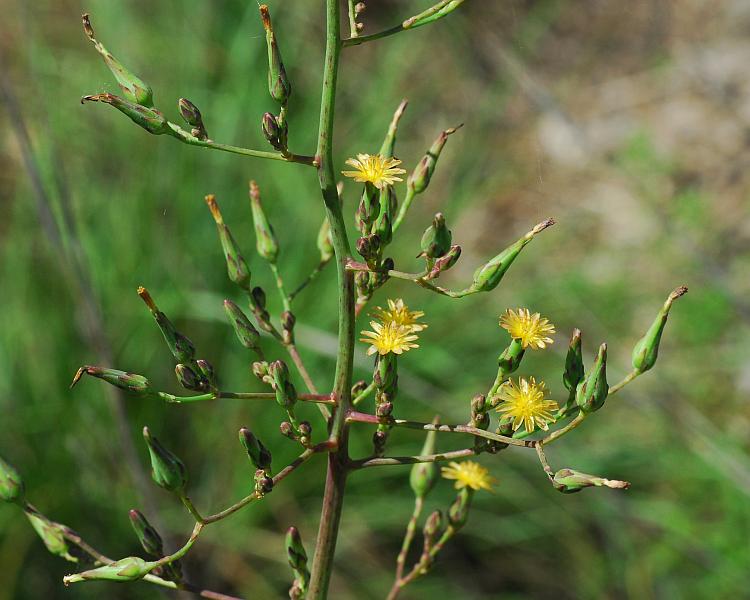Lactuca canadensis L.
Wild Lettuce

Native
CC = 3
CW = 3
MOC = 76
© SRTurner
Lactuca canadensis L.Wild Lettuce | |
 |
Native CC = 3 CW = 3 MOC = 76 |
© SRTurner |
|
Family - Asteraceae/Cichorieae Habit - Annual or biennial forb, with tan to orange sap. Stem - Erect, to 2 m, usually glabrous, hollow between the nodes, glabrous or rarely pubescent with short, curled hairs, often purple-spotted.
Leaves - Alternate, well-developed on stem, extremely variable. Basal and lower stem leaves mostly 20-30 cm long, sessile or more commonly with a winged petiole, narrowly ovate, ovate, or obovate in outline, variously toothed and/or deeply pinnately lobed, the margins minutely hairy, sometimes with a pair of narrowly triangular basal lobes clasping the stem, the undersurface with the midvein often short-hairy. Middle and upper stem leaves mostly linear to lanceolate, ovate, or obovate, pinnately lobed to nearly entire, the margins minutely hairy or rarely glabrous, the base narrowed or tapered, sometimes with a pair of narrowly to broadly triangular basal lobes clasping the stem, the undersurface glabrous.
Inflorescence - Highly branched panicles with numerous (50-100) heads.
Heads - Ligulate. Involucres cylindrical or urn-shaped, 8-10 mm long at flowering, elongating to 10-14 mm at fruiting, the bracts 17-19, glabrous.
Flowers - Florets 17-22 per head. Corollas orangish yellow or orange, occasionally reddish at the tip, sometimes turning blue with age or upon drying. Pappus bristles 4-7 mm long.
Fruits - Achenes with the body 3-4 mm long, 1.5-2.0 mm wide, dark brown to black, flattened, with prominent lateral wings and a conspicuous ridge on each face, tapered abruptly to a slender beak somewhat shorter than to about as long as the body.
Flowering - July - September. Habitat - Forests, savannas, sand savannas, prairies, sand prairies, streambanks, pond margins, pastures, fields, fencerows, railroads, roadsides, open, disturbed areas. Origin - Native to North America. Lookalikes - Other species of Lactuca. Other info. - This commonly encountered lettuce can be quite variable in appearance. The plant can be differentiated from other common lettuces by the presence of tan or orange latex; however, this character must be used in conjunction with other attibutes, since other species (e.g. L. hirsuta) also contain tan sap. Other key attributes include the dirty orange color of the flowering heads and a conspicuously leafy stem, though these characters are also variable. Lactuca canadensis is common across Missouri and the eastern half of the continental U.S. Photographs taken at Crowley's Ridge Conservation Area, Stoddard County, MO, 8-14-2009, Faust County Park, St. Louis County, MO, 11-22-2010, along the Katy Trail near Dutzow, Warren County, MO, 8-06-2015, Sand Prairie Conservation Area, Scott County, MO, 8-12-2015, and Otter Slough Conservation Area, Stoddard County, MO, 8-15-2021 (SRTurner). |